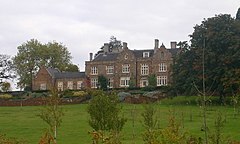Upper Catesby
| Upper Catesby | |
|---|---|
 Catesby House | |
| OS grid reference | SP526593 |
| Civil parish | |
| District | |
| Shire county | |
| Region | |
| Country | England |
| Sovereign state | United Kingdom |
| Post town | Daventry |
| Postcode district | NN11 |
| Dialling code | 01327 |
| Police | Northamptonshire |
| Fire | Northamptonshire |
| Ambulance | East Midlands |
| UK Parliament | |
| Website | Catesby (Parish Meeting) |
Upper Catesby is a hamlet in the civil parish of Catesby, Northamptonshire, about 3.5 miles (5.6 km) southwest of Daventry. The hamlet is about 550 feet (170 m) above sea level, at the top of a northwest-facing escarpment.[1]
Archaeology
In 1895 during the sinking of a shaft for Catesby Tunnel a Roman cinerary urn was found about 575 yards (526 m) south of Upper Catesby.[1]
Village
In 1389 Upper Catesby was recorded as Overcatsby.[1] It is a shrunken village.[1] The modern hamlet has only a handful of 19th- and 20th-century houses, but is surrounded by numerous earthen features showing where cottages and the main village street had been.[1] Most of the fields around the former village still have clear ridge and furrow marks[1] from the ploughing of the medieval arable farming with an open field system divided into narrow strips.
Catesby House
Catesby House is a Jacobethan country house about 400 yards (370 m) west of Upper Catesby. It was built in 1863 and enlarged in 1894.[2][3] It includes 16th-century linenfold panelling said to come from Catesby Priory,[2] and 17th-century panelling,[2] doorcases and a stair with barley-sugar balusters,[2] all from the previous 17th-century Catesby House[3] that was in Lower Catesby.
Catesby Tunnel

Catesby Tunnel is a disused railway tunnel on the route of the former Great Central Main Line. It passes about 250 yards (230 m) west of Upper Catesby and about 100 yards (91 m) east of Catesby House. The tunnel's north portal is about 400 yards (370 m) northwest of the hamlet, and its south portal is about 0.6 miles (1 km) north of Charwelton, just inside the southern boundary of Catesby parish.
The Great Central Railway intended its Southern Extension to pass through Catesby parish in a cutting.[4] However, the occupant of Catesby House, Henry Attenborough, owned much of the land in the parish and insisted that the line pass beneath it in a tunnel.[4] T Oliver and Son of Horsham, the contractor to build the Rugby Central — Woodford Halse section of the line, started the tunnel by sinking nine construction shafts in 1895,[1] and completed the tunnel in 1897.[4] The first Great Central services to use the tunnel were coal trains, which started running on 25 July 1898.[5] The line opened fully on 15 March 1899.
The tunnel is 27 feet (8.2 m) wide, 25 feet 6 inches (7.8 m) high, 2,997 yards (2.7 km) long[6] and has five air shafts.[5] Four of the shafts are in Catesby parish and each has a diameter of 10 feet (3 m).[5] The fifth is in the neighbouring parish of Hellidon, and has a diameter of 15 feet (4.6 m) for greater airflow.[5] About 2,900,000 cubic yards (2,200,000 m3) of material was dug out to make the tunnel.[5] The tunnel, its portals and air shafts are all lined and faced with Staffordshire blue brick[5] and a total of about 30 million bricks was used.[4]
On 4 January 1906 a rail on the Down track broke and derailed an afternoon express from London Marylebone to Manchester Piccadilly with about 50 passengers aboard.[5] The train was travelling at about 60 mph (97 km/h) and tore up about 440 yards (400 m) of track before it came to a halt.[5] All five coaches were derailed and the last coach fouled the Up track, on which a goods train was due.[5] The crew of the express acted to protect their train: the driver placed a detonator on one rail of the Up track and the guard sounded the train whistle, both of which gave the crew of the approaching Up goods enough warning to stop short of the wreckage.[5]
British Railways closed the Great Central Main Line through the tunnel on 5 September 1966, and the track was lifted shortly thereafter.[4] In recent years the tunnel has featured in numerous reopening proposals, one of which was as a possible (though rejected) route for HS2. Chiltern Railways have expressed an interest in reopening the route as far as Rugby or even Leicester. However, a proposal to convert it into a wind tunnel for testing Formula One cars was publicised in October 2014.[7]
References
- ^ a b c d e f g RCHME 1981, pp. 37–43
- ^ a b c d Pevsner & Cherry 1973, p. 145.
- ^ a b "Catesby House". National Heritage List for England. English Heritage. 24 February 1987. Retrieved 9 November 2013.
- ^ a b c d e Boyd-Hope & Sargent 2007, p. 76
- ^ a b c d e f g h i j "Catesby Tunnel". Forgotten Relics of an Enterprising Age. Four by Three. 2013. Retrieved 9 November 2013.
- ^ "page 1". Railway Tunnel Lengths website. Phil Deaves. Retrieved 9 November 2013.
- ^ "Formula One proposal for former Catesby railway tunnel". Daventry Express. 2014. Retrieved 29 May 2015.
Sources
- Boyd-Hope, Gary; Sargent, Andrew (2007). Railways and Rural Life: S W A Newton and the Great Central Railway. Swindon: English Heritage and Leicestershire County Council. ISBN 978-185074-959-2.
{{cite book}}: Invalid|ref=harv(help) - Pevsner, Nikolaus; Cherry, Bridget (revision) (1973) [1961]. Northamptonshire. The Buildings of England (2nd ed.). Harmondsworth: Penguin Books. p. 145. ISBN 0-14-071022-1.
{{cite book}}: Invalid|ref=harv(help) - RCHME, ed. (1981). "Catesby". An Inventory of the Historical Monuments in the County of Northamptonshire. Vol. 3 – Archaeological sites in North-West Northamptonshire. London: Royal Commission on the Historical Monuments of England. pp. 37–43.
{{cite book}}: Invalid|ref=harv(help)

